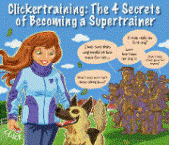Good Dog Training Advice
Get Fast & Simple Dog Training Tips to
Turn a Difficult Dog Into an Obedient Pet!
How to Stop Your Dog from Chasing Cats
Every now and then I wonder what it must be like inside a dog's head. What does he think about when a cat sits on a window sill and openly taunts him? I have my suspicions about what the cat is thinking, but what does the dog really want out of that interaction? In the end, it doesn't matter. The dog will chase the cat as surely as the cat will figure out a way to get out of reach. But, if you own cats or have them in your neighbourhood, this dog behaviour problem can be frustrating and even dangerous for both the cat and the dog. Why They Chase Cats Dogs might chase cats for a variety of reasons. When it comes to aggressive chasing, it is because they see a small, active form invading their territory. They want to chase the cat away, and 9 times out of 10 the cat will run away, which means the dog will continue to chase it. Some dogs might see cats as prey, but more often than not, it's a matter of territory and protection. In some other cases, the dog may just want to play or to get to know the cat. In other cases a cat might decide to be territorial and the dog will see it as a threat to his dominance. In any of these situations, the urge to track down the cat is extreme and can result in damage, danger to both animals, and a whole lot of noise. Stopping the Chasing When it comes to stopping dogs from chasing cats outside, you're probably never going to have full control of the situation. Like squirrels, your dog is going to go after cats. Luckily, you have a leash and collar on him so he isn't going anywhere. In the house, though, you need to make some changes. First, start by introducing the two in a room together. Keep your dog on a leash so the cat can get away if necessary. Now, make the dog sit and wait while the two meet. If the dog attempts to chase the cat, make sure to control the situation. Use a corrective command such as "no" with the leash firmly in hand. In some cases, an ornery cat can make this a lot harder, but if the dog learns that chasing the cat can make his life unpleasant, it will minimize proactive chasing. Dogs have a strong chasing instinct, so don't expect him to change after the first session. You'll need to correct this behaviour more than once - often times many times over - before he learns that you don't want him to go after that cat. Another good trick is to teach the dog the "leave it" command. Dogs can learn this quickly, and can apply it to all sorts of things they want. If you can teach them that they cannot have something when you use the command, they will learn to respond similarly when chasing a cat. The Long Term Some dogs are just not going to pick this one up. It's easy to say that any dog can learn any new behaviour, but when it comes to chasing small animals, some dogs are actually bred to do just that. Combine that with a cat that likes to taunt your dog or play around near him, and you have a situation that can lead to all sorts of chasing and knocking over of things. If you have too many issues, make sure to crate train your dog for when you leave or convert your cat to an outdoor cat. There are always solutions for cat vs. dog situations, no matter how frustrating they may be. Consistency is key and a whole lot of patience is the best way on how to train a dog. For the ultimate guide to stopping your dog from chasing cats and people, plus how to solve a large variety of other dog behavioral problems, see:
Click here to access Doggy Dan's dog training course here... | |
|


Discover the Secrets to Training Your Dog Or Puppy. Huge BONUSES for a limited time only!
Click here now...
|
http://GoodDogTrainingAdvice.com





